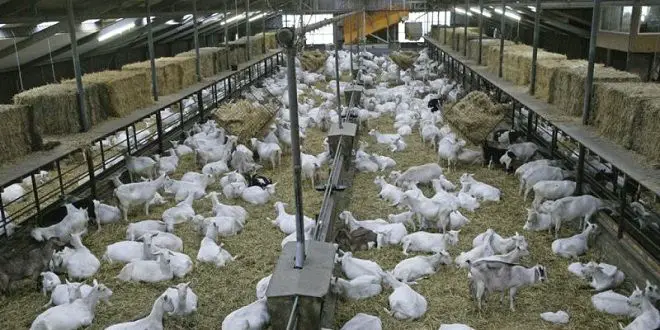
In this guide to raising dairy goats, we give you a complete beginner’s lesson on how to raise dairy goats, including the best dairy goat breeds, how to get started, costs, best practices for profitability, and much more!
Table of contents
- What is a Dairy Goat?
- Dairy Goat Breeds
- What is the best dairy goat breed?
- What Can You Get from a Dairy Goat? 4 Lucrative Dairy Products
- How to Raise Dairy Goats – Tips for Beginners
- How Many Dairy Goats per Acre?
- What to Feed Dairy Goats
- What would a balanced feed for dairy goats be?
- How to put weight on dairy goat?
- How to Start a Dairy Goat Farm
- What is required to start a goat dairy operation?
- How Long Do Dairy Goats Live?
- How to Increase Milk Production in Dairy Goats
- How to increase dairy goat milk production naturally
- How Much Does a Dairy Goat Cost?
- How much does it cost to raise a Dairy Goat?
- How Long Do Dairy Goats Produce Milk?
- Raising Dairy Goats for Meat
- How to introduce a dairy goat to a meat goat herd
- Raising Alpine Dairy Goats – Why Consider Alpine Goats?
- Dairy Goats for Sale Near Me – Where can I buy dairy goats?
- What should I look for when buying dairy goats?
What is a Dairy Goat?
As their name suggests, dairy goats are kept mainly for milk production.
Out of the estimated 2.6 million goats in 2018, about 380,000 (16%) are raised primarily for milk production in the United States. In 2012, only 12% of the total count was kept for milk production. We can therefore notice the trend is going up and that producers all across the country are looking into dairy production.
Dairy goat production continues to be an important part in the livestock industry in North, Central and South America. Goat milk and other dairy products offer consumers with health, nutritional and environmental benefits.
The United States is not yet a global goat milk producer but dairy goat numbers have been in the rise in the past decade. Dairy goat farms are on the rise since people prefer high quality locally sourced goat cheese. Rising demand is driving the increase in dairy goat production. Immigrants from Asia, Middle East, Africa and Mexico are the leading demand for goat milk.
Dairy Goat Breeds
States that practice dairy goat farming at large in the United States are Pennsylvania, Wisconsin and California. Dairy goat farming varies in different states.
Compared to cows, goats are the easiest dairy animals to keep because they require little capital, small space; their milk is highly nutritious and digestible and they have a high prolificacy (number of litter born per kidding).
Dairy goat breeds are the goats with high milk production. There are over 50 milk producing goat breeds around the world. Some have high milk production rate which are suitable for milk production while others produce small amounts of milk which are suitable for small scale production. Below I will share some of the dairy goat breeds and the best dairy goats to consider when starting your dairy goat farm. Origin and characteristics of the highly productive dairy goats are described below;
What are the main breeds of dairy goat?
- Saanen goats: These goats originated from Switzerland. On average a Saanen goat can produce about 2000 pounds of milk in a year, according to the ‘American Dairy Goat Association’ (Cooper, 2012). White to pale cream in color, they have black spots in the udders and nose. Their ears are erect and pointed facing forward. The highest recorded milk yield is 1800 pounds in 205 days. Butter Fat (BF) content is 4%. A mature male weighs about 165 pounds while a mature female weighs about 110-130 pounds.
- Alpine goats: These goats originated from the French Alps and were introduced to the USA in the 1920s. These breed of dairy goat adapts better then the Saanen in the tropics. Female weigh 130 pounds and male 140 pounds at maturity. Milk yield averages at 10pounds per day and the BF content is 3.6%. German Alpines are the more widespread and color varies from:
- White front quarter and back hind.
- Black neck and white hind.
- Grayish front and back hind.
- Toggenburg goats: Originating in the Swiss Alps, Toggs produce an average of 2000 pounds of milk per year. Mature males weigh 140 pounds and females weigh 100 pounds.
Toggenburg goats have white legs, white strips from nose to eyes and have brown bodies from dark chocolate to fawn. They can produce milk for a long time if not served are good for upgrading local breeds.
- Nubian goats: These goats are as a result of cross breeding English goats with African and Indiana goats. Their body color varies and at maturity can weigh up to 135 pounds.They have long dropped years and are a large sized breed. Nubian goats produce 1700 pounds of milk annually.
- LaMancha goats: A cross breed of Nubian and dairy goats, they are high producers of milk and average 10 pounds of milk per day. Mature goats weigh 130 pounds and 28 inches in height at the shoulder. They can be of any color.
- Nigerian Dwarf goats: Just as it is called, these goats originated in Nigeria. They can produce 700 pound of milk annually and weigh around 80 pounds at maturity. They are the smallest dairy goat breeds with a height of 28 inches at the shoulder.
The above dairy goat breeds are adaptable to a wide range of climatic conditions and can do very well in any state. Alpines and Saanen are hardy and can do well in hot areas. Toggernburg do well in cold areas.
What is the best dairy goat breed?
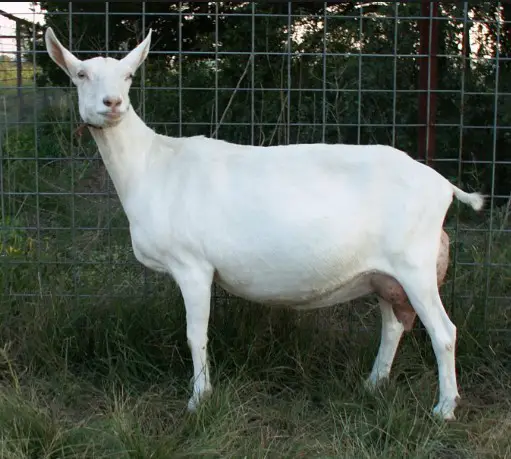
Saanen Goats
The Saanen is widely recognized as the highest milk-producing breed. The Saanen originated from the Saanen valley in Switzerland. The total world population is reported to be over 1 million heads.
The goats are white to pale cream in color and have occasional black spots on the udder, nose and ears.
It has been reported that the average milk yield of a Saanen goat raised in good conditions, hardly can be reached by 10 fiber goats. They are prolific and have a high twinning rate.
The Saanen breed in recent years has been the most widely exported dairy goat around the globe and has established as Weisse Deutsche Edelziege (German Improved White), British Saanen, Dutch White goat and so on.
Saanen goats under good care can produce 700 – 900 kilograms of milk between 280 and 300 days in a lactation period. Mature males average a weight of 165 pounds while females average 130 pounds.
Feeding Saanen Goats
Just like any other goats, Saanen should be fed on balanced diets consisting of energy, protein, minerals, vitamins and clean water. These can be found from grasses, shrubs, plants and weeds.
- Energy: Sources of energy nutrients are alfalfa, cereal grains such as oats, wheat, corn and barley, grass. Energy limitations may lead to inadequate feeding which can therefore lead to loss of weight, reduced production and infertility
- Protein: is made of amino acids which are vital to all body processes High quality protein can be found in high quality legume hay.
- Minerals: minerals are essential to the functions of an animal. Classified as macro and micro, macro minerals like calcium, magnesium, phosphorus and salt would be essential in the goat’s diet. Micro minerals in the goat’s diet would be zinc, copper, iodine, cobalt, iron and manganese.
- Vitamins: Divided into water soluble and fat soluble, fat soluble vitamins are stored the lipid portion of the feed and include Vitamins A, D, E and K. Water soluble feeds are met by feedstuffs.
What Can You Get from a Dairy Goat? 4 Lucrative Dairy Products
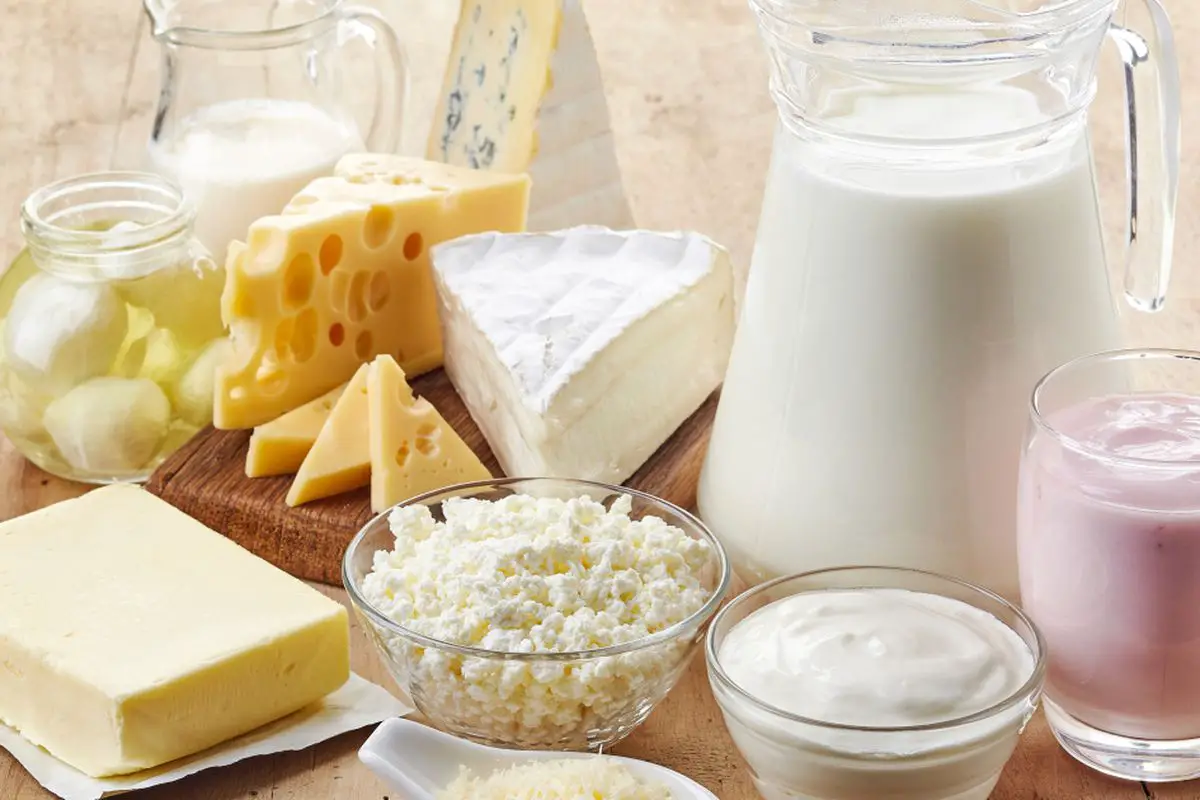
Dairy products have played an important role in the economic growth of many developing countries. Producing high quality raw milk is of utmost importance for successful production of dairy goat products. The products must be safe to consume, free from spoilage of bacteria and have a good taste without any flavors.
Cheese is the major commercially produced goat product. Many other dairy products are available such as frozen, condensed, fermented, beverage and dehydrated milk products.
Products such as fluid, evaporated and powdered goat milk products have been produced and marketed in the United States.
Below are the top dairy products from dairy goats:
- Quality goat milk
Goat milk is white, with a slightly sweet taste and has no odor. High-quality pasteurized goat milk must contain no pathogens or foreign substances. In the United States, the regulations of production, processing and marketing of dairy products are described in the federal Food and Drug Administration (FDA) publication called Grade A Pasteurized Milk Ordinance (PMO).
- Cheese
Agriculture Handbook No 54 of the U.S. Department of Agriculture records over 400 varieties of goat cheese and describes over 800 names of cheese, many which are made from goat milk.
Cheese can be used in cookery, production of cream cheese mask for dry skin etc.
- Frozen Products
Products like frozen yoghurt and ice cream can be manufactured from goat milk. Ice cream is consumed heavily by high school and college kids and is a popular dessert in the United States. The most popular ice cream flavors are Vanilla, Chocolate and premium white mixes.
- Yoghurt and Buttermilk
Yoghurt is one of the major cultured products. Goat yoghurt is softer and less viscous. It lacks the flavor of cow milk yoghurt. It is made from whole milk which has 3.2 percent fat, low-fat milk or skim milk. Buttermilk is made from skim milk using the by-product from churning butter out of sour milk.
Other products you can get from dairy goats;
- Ghee- this is a butterfat product manufactured by fermenting whole milk into curd and churning out the butter.
- Cosmetic products- Cosmetic products such as lotion, face scraps, goat milk soap are manufactured largely in the United States.
How to Raise Dairy Goats – Tips for Beginners
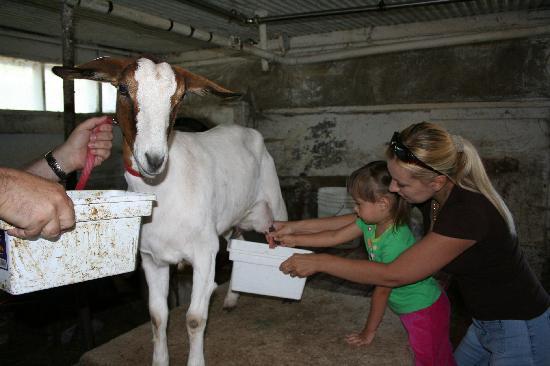
Consumption of goat milk has been on the rise in recent years because it is easy to digest and people with allergies to cow milk can consume it.
Goats are easy animals to raise compared to other dairy animals. They’re inexpensive to keep compared to cows. Below I will guide you on what to consider when setting up your dairy goat’s farm.
- Dairy Goat Breed
This is the first step you have to consider. When choosing the right breed for your farm, you have to look at the adaptability of the breed to the climate in your area. Goats like Saanen, Toggenburgs and Alpines that originated in the Swiss Alps do well in cool climates. Nigerian Dwarfs and Nubian goats have more tropical origins and do well in the summer.
Other factors to consider when choosing the best dairy goat breed are their reproductive capabilities and twinning rates.
- Feeding the Dairy Goats
Just like any other animals, goats require a balanced diet. If you have adequate land, you can raise your goats on pastures. Make sure to check if the forage area is free from toxic plants that may affect the goat’s health. Fresh feeding high quality hay is common in seasons when forage is not available. Make sure to provide adequate food for your herd in order to get maximum produce.
- Housing and Fencing
You will need to fence the pasture area to keep predators away and also prevent the herd from roaming to the neighbor’s compound. Goats also need a clean, dry, well ventilated house that keeps them warm in winter.
- Vaccination and Treatment
The saying, “An ounce of prevention is worth a pound of cure” applies to goats. It’s cheap and easy to keep your animals free from diseases and illnesses than to treat them when sick. Always make sure you vaccinate your herd to keep them safe from infections and to have a healthy herd.
How Many Dairy Goats per Acre?
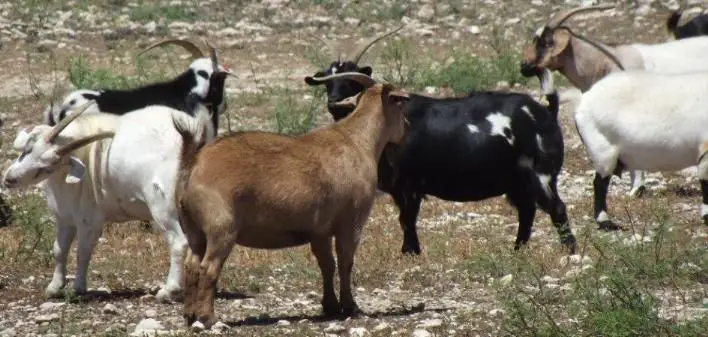
Dairy goats can be reared on a small acreage by using supplemental feed. If using an extensive system, then one can keep 2-10 goats depending on the availability of grass and plants. But before keeping a goat, there are some few steps you have to consider.
- Permission: Some states have codes against keeping livestock so it is advised to first check with your local authority.
- Prepare fencing and shelter: Planning and good herd management is the key to success. Make sure you have built pens and shelter before picking your goats. Roaming space should be at least 200-400 square feet for smaller breeds and twice for larger breeds.
- Dairy Goat Breed: Pick a smaller dairy goat breed if you have a size limit.
What to Feed Dairy Goats
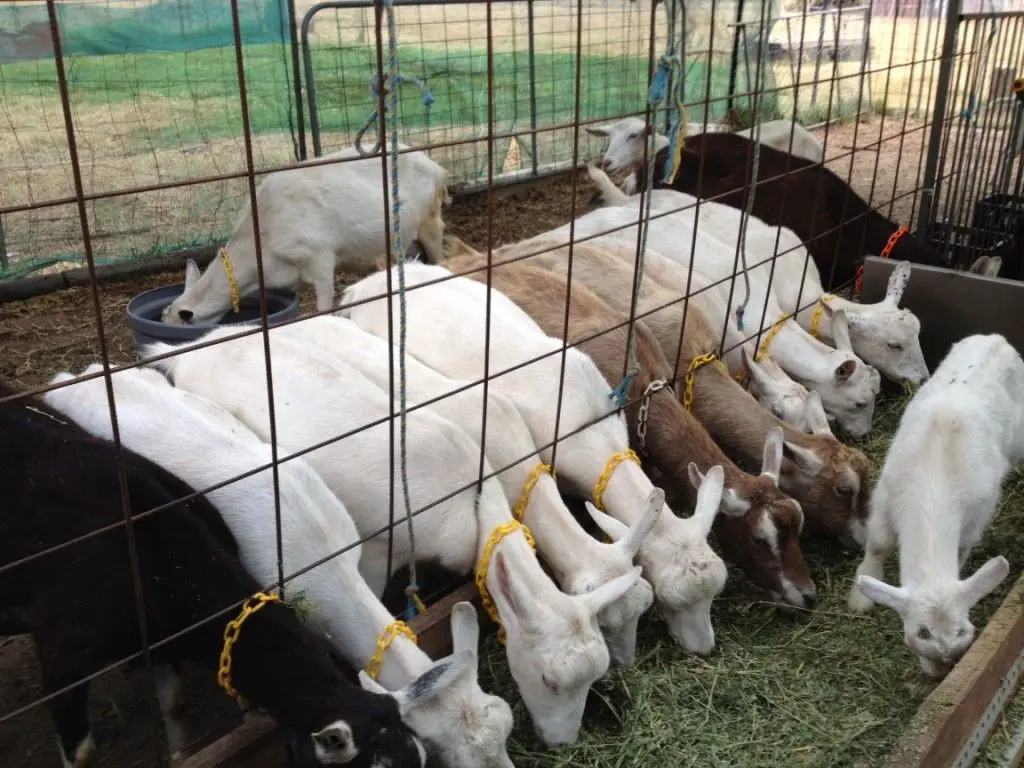
Goats are relatively easy to feed (can feed almost all types of foods) and do not require a lot of space to rear. Below is some important information on goat feeding which should help producers keep highly productive dairy goats.
- It is advised to make pastures for your goats.
Natural food from pastures helps in increasing the digestibility of other foods. Natural pastures offer sufficient and necessary nutrients like energy and protein. Pasture with plants, grasses and weeds are healthy and increase the productivity of your dairy goats.
- Vitamins and Minerals
Presence of vitamins and minerals in goat feed is a must. This is because they keep the goat productive and help in keeping away various diseases. For proper growth and production, vitamins like Vitamin A, D and E should be available and regular in their daily food. Minerals that are useful to your dairy goats are feed elements like calcium, phosphorus and salt.
- Hay
There are various types of hays available in the market like timothy and alfalfa. They are highly enriched in protein and are an important source of nutrients for your goats. You can feed hay in winter seasons when there is inadequate forage.
- Grain
Grain is a source of proteins and carbon for goats. You can feed your herd oats, barley, corn etc since they are a source of energy and carbon. You can feed your goat 10% to 16% grainy formulated food to your goats if natural food is unavailable.
You can also feed your goat kitchen scraps like fruit cutting, vegetables, banana peels etc.
What would a balanced feed for dairy goats be?

There are five major categories of a balanced diet for dairy goats:
- Water assists in assimilation of nutrients, excretion of waste products, assists in digestion, milk production and controlling the body temperature. Access to clean water is very important.
- Protein– the most common and economical sources of protein for dairy goats are the oilseed meals: soybean, sunflower, peanut and cottonseed. Other sources of protein are high quality hay.
- Energy– Sources of energy in a goats diet are; barley, oats, wheat. Grasses are also a huge source of energy for the animals.
- Vitamins– Vitamins A, D and E are some of the most essential nutrients that your goat feed should have. Vitamin A is found in kitchen scraps like carrots, banana peels etc while Vitamin E is found in oilseed meals like soybean.
- Minerals– Minerals like calcium and phosphorus are essential minerals. Calcium deficiency manifests itself in milk fever (after kidding). Phosphorus deficiency manifests in lower milk yields and lethargy. Other minerals that are essential in the diet are Magnesium, Zinc, Manganese, Iodine, Copper, Iron, Sodium and Potassium.
How to put weight on dairy goat?
Goats are very energetic and burn a lot of calories through running around. With a bit understanding of the nutritional needs of dairy goats, even the newest producer can raise healthy fattened goats.
- Feed them grass
Eating grass, plants and weed is the most beneficial and natural ways to add weigh on your goats.
- Feed the goats protein
Protein aids in proper levels of carbohydrate digestion. It helps in digestion and absorption of minerals .
- Feed grains.
Because of their high carbohydrate content, grains like oats and corn are the easiest way to fatten your dairy goat.
- Provide plenty of water.
Water aids in digestion and absorption of minerals.
How to Start a Dairy Goat Farm
Dairy goat farming is very profitable yet simple and easy to start. Dairy farming is recognized all over the world because goat milk and dairy products have a great demand.
The steps of starting a dairy goat farm are described below.
- Dairy Goat Breed
Choosing the right breed according to your area plays an important role in productivity. Choose breeds that are adaptable, easy maintained and have high production. Breeds like Saanen, Alpine, Nubian and LaMancha are good dairy goat breeds that are highly productive and popular.
- Feeding
Good feeding practices increase the milk production. Always feed your herd a balanced diet. Along with providing good quality food, provide the goats with fresh and clean water.
- Housing
For commercial dairy farming, multiple big pens will be suitable for housing your large breed goats. Always keep the pens clean, dry and well ventilated.
- Breeding
Dairy goats breed in the fall and produce kids in the spring. With recent modern farming methods, producers can now breed the herd throughout the year. Artificial insemination is effective in commercial dairy farming.
What is required to start a goat dairy operation?
The following are essential requirements before you start a dairy goat farm.
- Make a to do list before starting any operation.
- Have ready housing and shelter.
- Make a fence around your farm to keep predators away.
- Have good quality feed ready. If possible, you can provide pasture for the goats.
How Long Do Dairy Goats Live?
The age expectancy of dairy goats depends on the dairy goat breed.
Does live longer than bucks with an 11-16 year life span. Bucks that live past the age of 10 are unusual due to stress. Alpine goats are extremely hardy and have a life expectancy of 8-12 years.
If nourished well, Saanen goats can live past 15 years of age.
The live expectancy of Toggenburg goats is 8-12 years.
Nigerian Dwarf goats are found on many small dairy farms in Southern US. Their high milk production makes them a common breed in the south. Their life expectancy is 15 years.
How to Increase Milk Production in Dairy Goats
The two most important factors in order to increase milk production in dairy goats are; the quality of hay and the grain mix.
- Providing quality healthy feeds
Feed your dairy goats with high quality legume hay like alfalfa. Quality hay provides 10 to 20 percent protein.
Feed your dairy goats 2 to 3 lbs of grain every day. Quality grain feeds may include oats, corn, and soy beans. This should provide 15 to 20 percent protein.
Fiber encourages goats to chew thus stimulating rumination. Good fiber sources are sunflower and cotton seeds. When goats don’t chew enough, the milk fat content decreases.
To maintain and increase milk production, goats should be fed with a balanced diet based on requirements defined by the National Research Council (NRC).
How to increase dairy goat milk production naturally
- Feeding your goats on pasture
Natural food from pastures helps in increasing the digestibility of other foods. Natural pastures offer sufficient and necessary nutrients like energy and protein. Pasture with plants, grasses and weeds are healthy and increase the productivity of your dairy goats
Keep your dairy goats stall clean and dry. Wet surfaces cause stress to goats hence lowering their production yield.
How Much Does a Dairy Goat Cost?
The typical price range is USD 250 to USD 500. The cost of a dairy goat varies with the breed, age and production rate. Large breeds cost more than small breeds. If you have financial constrains, it is advisable to buy young goats since they are not as expensive as the adults.
How much does it cost to raise a Dairy Goat?
The cost of raising a dairy goat depends on the breed, age, registration, health and the place of purchase.
- Veterinary costs: this will include the vaccination of the herd, regular veterinary checks and treatment of sick animals.
- Breeding: Purchasing a breeding buck will cost roughly 100 dollars. Renting typically cost 50 to 100 dollars per doe.
- Feed: grain prices vary but we pay around 12 dollars per 40lb bag. High quality Timothy hay cost 5 to 10 USD per bale.
- Labor: it is the largest expense in dairy goat farming. It amounts to 30% of total costs. Labor costs typically USD 5 per hour.
Other costs incurred when keeping dairy goats are the operating expenses like maintenance, utilities and supplies.
How Long Do Dairy Goats Produce Milk?
After kidding, does begin to produce milk. If she is milked, she will lactate for 10 months. They should be allowed to dry up for 2-3 months before being bred again.
You will breed your does once per year. Once they are bred, keep the bucks away from the does or the milk may taste off.
Raising Dairy Goats for Meat
Many producers opt to keep goats for both milk and meat production. If you choose this farming practice, then breed a high-quality meat buck with a high quality dairy doe.
For instance, crossbreed a Boer and Alpine goat and you will get a milk meaty offspring. You will make profits in selling of milk and other dairy product while also cashing in on the sale of meat.
How to introduce a dairy goat to a meat goat herd
Before you introduce your dairy goats to a meat goat herd, you have to develop a basic protocol for the farm. A good protocol will help you manage your herd to keep your animals healthy and productive, and should include criteria for identifying how many bucks and does you will keep in a single pen. Give some thought to the number of does you want to breed with the meet goats in a given month.
Raising Alpine Dairy Goats – Why Consider Alpine Goats?
Alpine goats are known for their high milk production. They are medium to large-sized goats that originated from the French Alps. Alpines were introduced to America in the early 1800s but became a sough-after breed after the 1904 World’s Fair due to their unique characteristics.
Characteristics of Alpine goats
- Alpines are the only breed with erect ears and come in a variety of colors.
- They are ready to breed at 5 months of age and 6 months of age for bucks and does respectively.
- They are hardy and can adapt to any climate with ease.
- Alpines are very fertile and tend to have twins. The gestation period is 150 days and it is advised to breed the does when they weigh about 80 pounds.
- A mature doe weighs at 135 pounds and bucks at 160 pounds.
- Milk yield averages at 10pounds per day and the BF content is 3.6%.
The cost of buying a proper doe ranges from $100-$300. The price depends with the goat itself so before purchasing one; ask for the history of the goat.
Other tips you need to know before buying the goat are:
- Create adequate space for the goats.
- Proper housing and fencing where the goats will live in and pasture.
- You will also factor the cost of food and vaccination shots.
Dairy Goats for Sale Near Me – Where can I buy dairy goats?
There are many farms where you can buy goats in the United States. There are many accredited dairy farmers and breeders across the country.
It is advisable to buy dairy goats from a well known breeder since they can show you details of the goats you want to purchase; the history, age and health of the goats. Below are some recommended dairy farms where you can buy dairy goats.
- Treasured Sunrise Acres, Indiana.
- Popular Hill Dairy Goat Farm, Minnesota.
- Fox’s Pride Dairy Goats, New Hampshire.
What should I look for when buying dairy goats?
Be sure to choose a reputable and recognized breeder. Ask the breeders reputation from several people before purchasing the dairy goats from him/her. A good breeder has records for every animal and will also show the performance of the animals in the herd.
Before buying a dairy goat, you should have decided what breed you want and a breed that fits your milk production goals.
Choose breeds that are hardy, can adapt to any climate and easily managed.
Visit various farms and compare the animals from different farms before making a conclusion.
Frequently ask questions. If it is a female, ask if she has ever been bred before, how many litters she had. Also ask the age of the animal, the cost of the goat and why the goat is on sale.
References:
Websites:
- How to Choose Among Breeds of Dairy Goats | Hobby Farms
- AgAmerica Land Loans & Agriculture Farming
- British Alpine Goat Breed – Everything You Need to Know
- Langston University Goat Research e
- MAFRI Goat
- Merck Veterinary Manual
- Goats and Their Nutrition
- North, Robert & John Seaman. Goat Health (Prime facts)
- Dairy Goat Management: Best management practices
Books:
- MLA (2009). Advisers Guide to Good Dairy Herd Management in the Tropics: A Manual for Dairy Advisers, Technical Staff and Other Dairy Specialists. Meat and Livestock Australia, Sydney.
- Belanger, Jerry. Raising Milk Goats the Modern Way. North Adams, Mass.: Storey, 1990.
- National Research Council Committee on Animal Nutrition. Nutrients Requirements Washington, D.C.: National Academy Press, 1981.
- Storey’s Guide to Raising Dairy Goats




